Sunset rises
There are only a few streets in the world whose names conjure images of a particular time and place: Wall Street. Champs-Élysées. Lombard Street. Hollywood Boulevard. Bourbon Street. Abbey Road. Fifth Avenue. Surely among them is Sunset Blvd., at least in part due to the 1950 film noir entry named after the street (often ranked among the best films ever made).
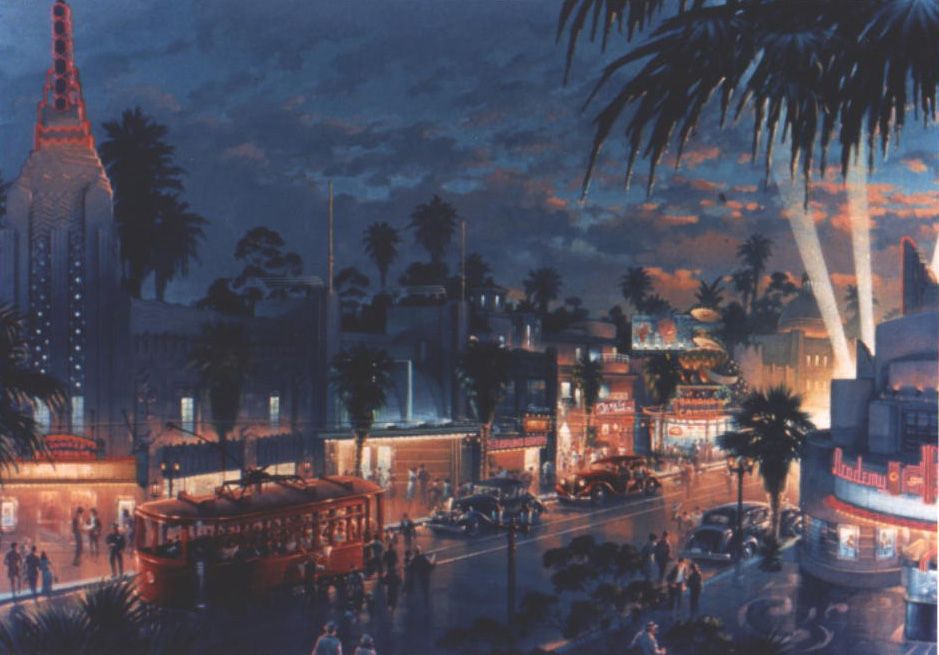
The real Sunset Blvd. stretches from the Pacific Coast Highway in Pacific Palisades east to Figueroa Street in Downtown Los Angeles – a major thoroughfare in the Beverly Hills and West Hollywood (including the world-renowned Sunset Strip).
At the Disney-MGM Studios, Sunset Blvd. would be a natural extension jutting north off of the park’s existing Hollywood Blvd. “main street,” creating an entirely new “land” in the tiny park. Ground was broken on the massive expansion at Disney’s Hollywood Studios, and by November 1993 (below), the streetscape of Sunset was coming to life.
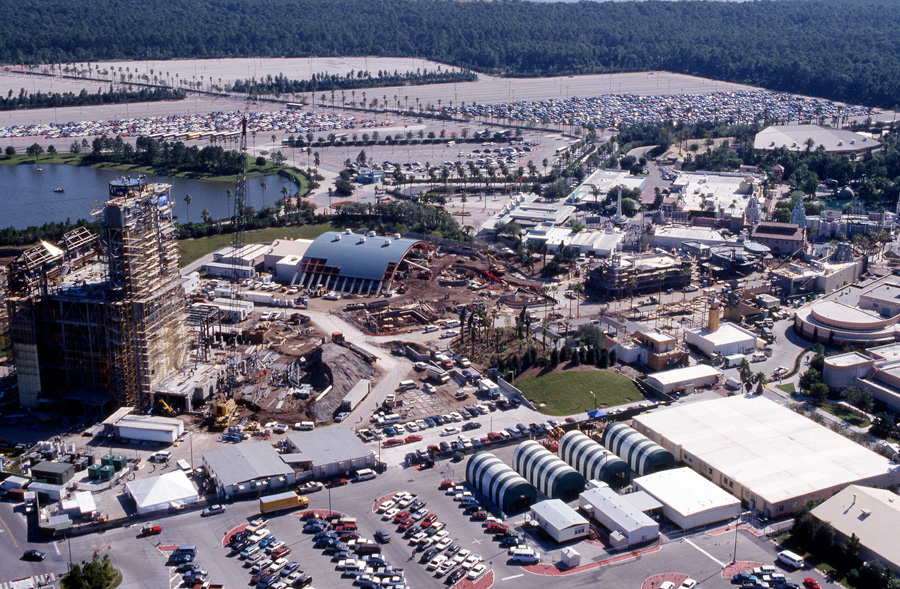
The land would immensely expand the park with dining and retail (disguised in an extension of Hollywood Blvd.’s Golden Age architecture, including a replica of the real Carthay Circle Theater). Just as importantly, it would represent a turn away from the park’s studio-centric ambitions. Given that the “studio” part of the Studio park hadn’t exactly worked out, Sunset Blvd. and its headliner would be an about-face, re-orienting the park around cinematic thrills.
With a ride system established, the Hollywood Tower Hotel began to take shape. The Neo-Mediterranean / Spanish Gothic building would be a veritable fortress of red tiled roofs, arched doorways, keystones, stucco walls, twisted columns, minarets, and pointed stone turrets. It would be imposing, dark, and foreboding, and that’s without the scortched lightning strike and the flickering, sparking neon sign.
Aged, weathered, and eroding, this dying icon of a long-lost Golden Age would loom over a brand new expansion for the park. ‘Sunset’ would be the perfect place for this once-grand fortress for the Hollywood elite, now rotting under decades of decay.
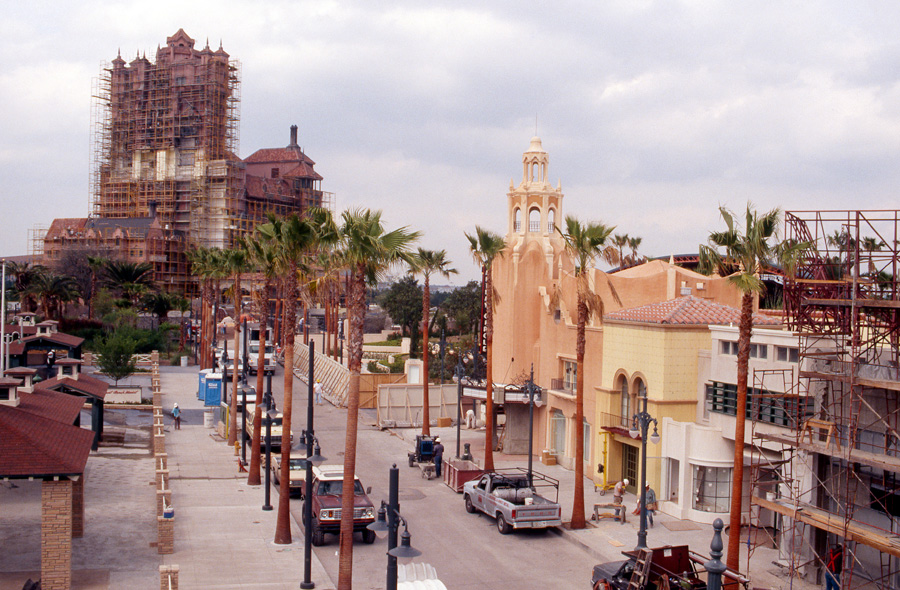
Modeled in part after the real Hollywood Tower, the statuesque hotel is obviously a landmark, standing 199 feet tall (any taller and it would require a flashing red aviation beacon that Imagineers expected would distract from its atmosphere – one of the most well-known bits of Disney Parks trivia ever) at the end of Sunset Blvd.
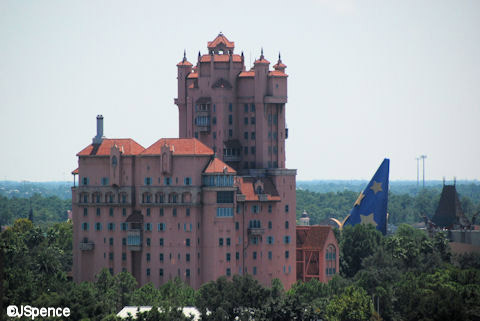
But what might be surprising is the depth of the building. Its guts – where the show scenes take place – are housed in the enormous (but exceptionally designed and decorated) showbuilding behind the tower. Though Disney would probably prefer that you didn’t see it, this enormous box is where a bulk of the show takes place. It’s the AGVs horizontal movement that carries guests into the tower out front with its sheer drop-off, making the hotel appear even more imposingly tall than it already is.
The Twilight Zone Tower of Terror held its debut at the Disney-MGM Studios on July 22, 1994. Are you ready to face the history of the Hollywood Tower Hotel? Let’s step inside…
Haunted history
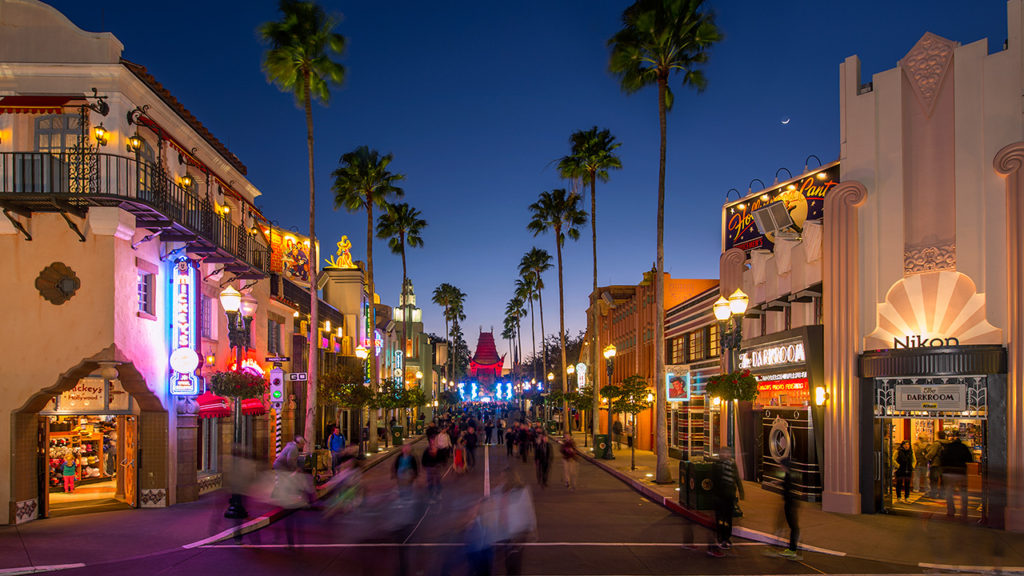
Welcome to the Disney-MGM Studios — a joyful celebration of the magic of the movies. This dreamy paradise for cinephiles has barely celebrated its fifth anniversary, but things here have already changed tremendously.
While trams still buzz through beige sound studios in the park’s rear half, the Declassified Disaster: Backstage Studio Tour and its two hour tour through the filmmaking facility has already folded. It turned out that hot sets, blockbuster productions, and celebrities never really made Orlando the new Hollywood, so the new version of the ride — the Studio Backlot Tour — is a respectable 25 minutes, mostly built around Catastrophe Canyon.
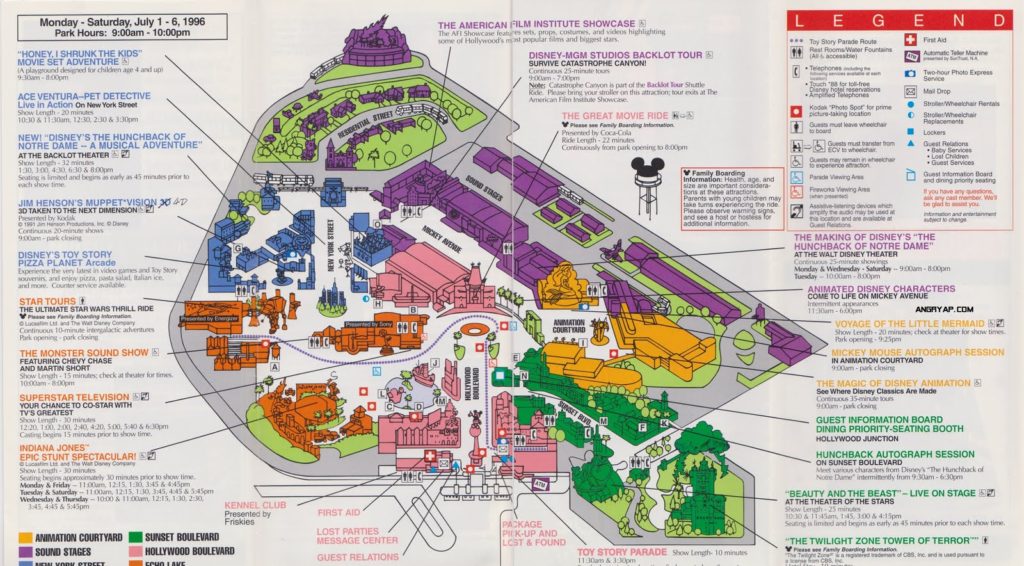
Without a studio proper to prop it up, the Disney-MGM Studios has become a test bed for a new way of doing things at Disney Parks. Yes, the “Ride the Movies” mantra is in full swing!
Already, the relatively small movie park has dedicated plenty of attractions aligned not just to Disney’s emerging slate of new, hot films (Beauty and the Beast – Live on Stage, Voyage of the Little Mermaid, “Honey, I Shrunk the Kids” Movie Set Adventure, and the Magic of Disney Animation), but to characters outside Disney’s catalogue (for now), like Indiana Jones Epic Stunt Spectacular, Star Tours, and Muppet*Vision.
And that new vision is brought to life on Sunset Blvd.
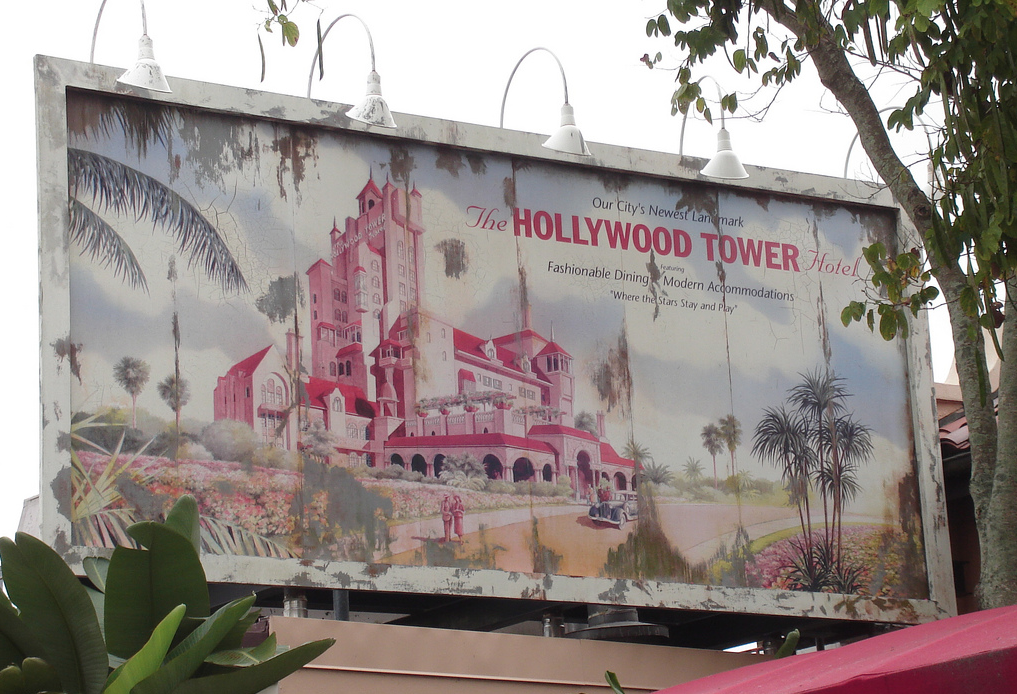
Unlike the barren, blacktop backlot, Sunset Blvd. is a return to form for Disney’s artists and storytellers; it’s a sister of Hollywood Blvd. with all the details, care, and romanticism of a long-lost Hollywood “that never was, but always will be.” The street is lined with art deco architecture, neon signs, elegant movie palaces, department stores, and farmers markets with truckloads of produce brought in from California’s verdant farms…

Sure, there may not be a real place on the map that looks quite like Sunset Blvd., but this is the Hollywood we believe in; the one we imagine in our dreams. Or perhaps nightmares… After all, at the horizon point of the Pacific Electric Trolley tracks embedded in the street and well past the decaying, peeling billboard announcing its starring role stands the husk of the Hollywood Tower Hotel
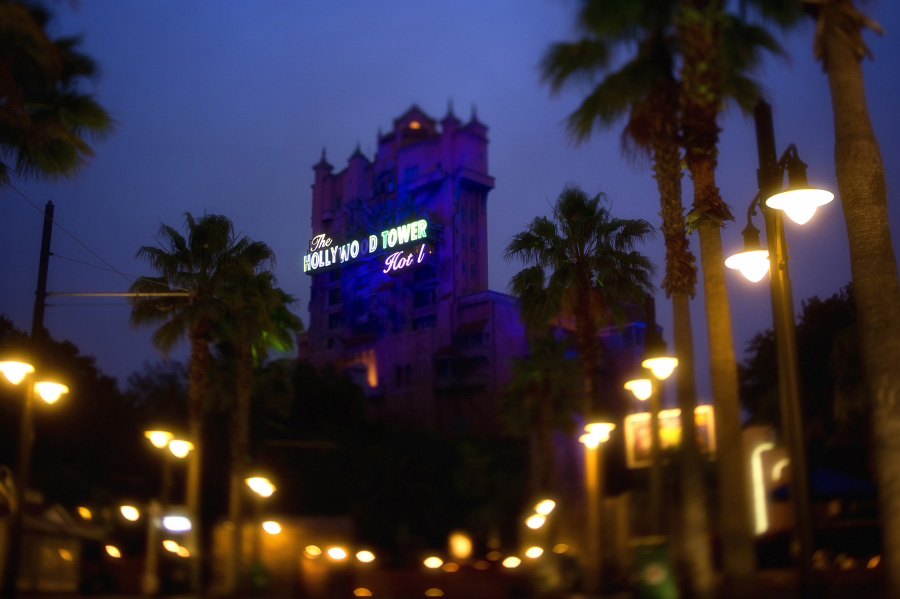
Somehow, the looming structure is hypnotic; a lost landmark of Tinseltown comprised of sunset-hued walls, twisted towers, stone chimneys, and pointed minarets that echo Spanish Revival architecture. As children divert their eyes in fear of signaling their desire to get closer, the Hollywood Tower Hotel nonetheless pulls you in. It’s otherworldly.
Only as you grow closer might you notice that this once-palatial icon is frozen in a state of disrepair. Its glowing neon sign spelling out “The HOLLYWOOD TOWER Hotel” is misaligned, its letters rusting off their scaffolds, flickering and sparking; behind them, the hotel’s 199-foot tall face is marred with the black soot and grime of a fire, but scarred outward from a central point – a lightning strike. And besides, part of the hotel is simply missing… Two elevator shafts are exposed as their corresponding guest towers — the ones we saw in that billboard — look as if they’ve crumbled away… yet there’s no rubble beneath…
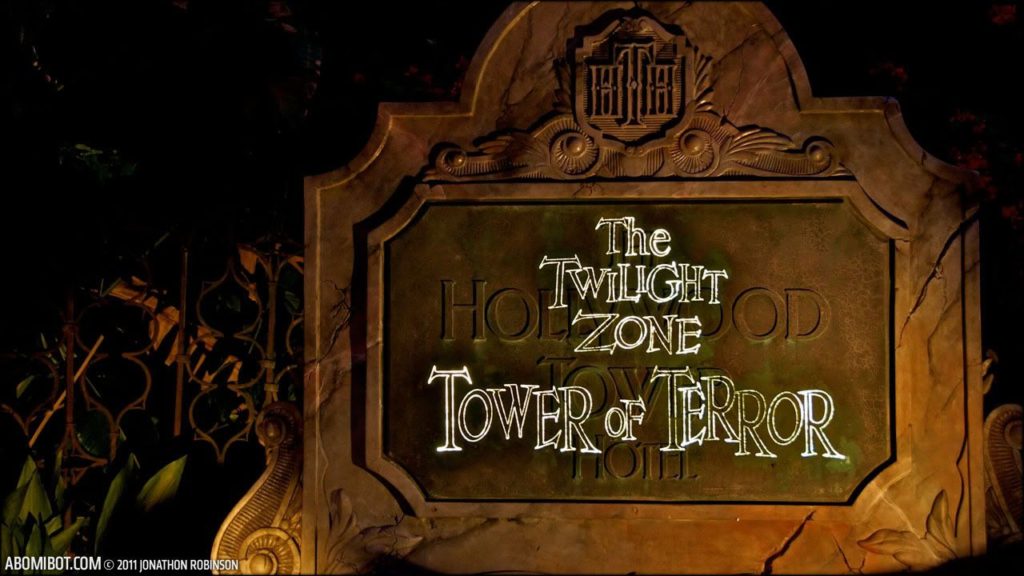
Even the hotel’s ornate bronze plaque bearing its name has aged and corroded… but stick around long enough and the grand marquee will begin to flicker. Supernatural dots of light will race across its face just subtly enough, you might wonder if it was an illusion… Until a new logo shimmers to life across the plaque’s face: THE TWILIGHT ZONE TOWER OF TERROR.
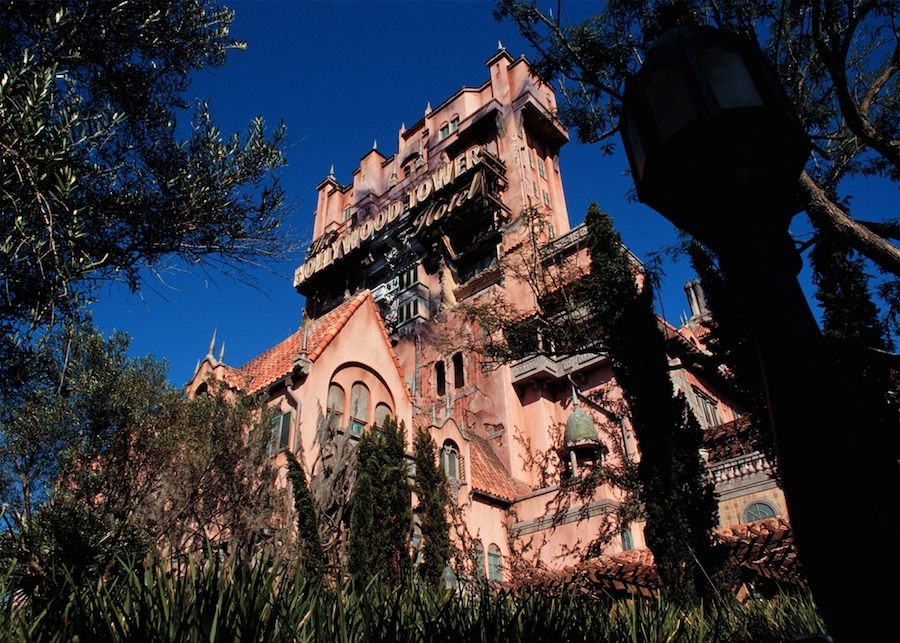
In fact, our tour through the remains of the Hollywood Tower Hotel begin in its once luxurious grounds. Winding paths ascend through misty gardens that might’ve once made for mind-clearing morning walks for Hollywood starlets. Diverging paths point toward tennis courts and Olympic swimming points, but given that the gardens have been overtaken with hostile plants and overgrown arbors, it’s likely that those ammenities have long been lost to time and the elements…
All the while, the grounds are filled with the distant, echoing, and eerie sounds of Duke Ellington, Fats Waller, and Glen Miller, as if these long-lost standards have somehow saturated the abandoned grounds, reverberating from a phonograph of another time. Eventually, the queue winds around the hotel’s elegant veranda, where vines have overtaken stone pillars and once-welcoming fountains run dry… and into the hotel’s main doors.
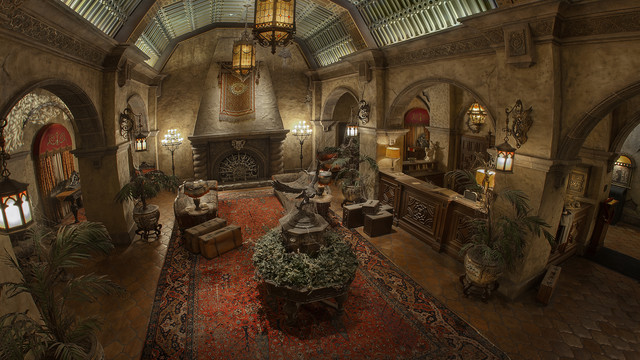
It’s clear that long ago, the Hollywood Tower Hotel would have indeed been a star. The sensational lobby with its arched ceiling panels and decadent antique rugs recalls an era of stardom and style. Yet today, the lobby’s art have become artifacts, caked in dust and age. What’s more, the lobby is frozen in time, with half-drank glasses of scotch; toys left abandoned on couches; a game of majong paused in mid-play…





It’s clear that whatever happened here to dim the lights of Hollywood’s brightest showplace happened in a flash, with patrons abandoning the hotel and never returning.
Behind the check-in desk, we’re led to a vestible outside of two ornate sets of wooden elevator doors… both bowed outward and cracked from within. Only one thing can cause such an unusual appearance: the rapid compression and pressurization of air beneath a counterweight. A falling elevator. The group pushes further into a dusty, dark library, filled with scattered books (and for the eagle-eyed, props from The Twilight Zone). A single curtained window shows that outside, a storm is rolling in… not unusual for Florida, of course, and we’re lucky to have made it inside as the first sheets of rain begin to fall.
As the group gathers inside, a sudden crack of thunder and flash of lightning sends the room into pitch black darkness. Only the loud buzz of static from a small television hoisted in the library’s corner lights the room, supernaturally springing to life with the introduction of The Twilight Zone by the inimitable Rod Serling…
“Hollywood, 1939. Amid the glitz and the glitter of a bustling young movie town at the height of its Golden Age, the Hollywood Tower Hotel was a star in its own right… a beacon for the showbusiness elite. Now, something is about to happen that will change all that.”
On screen, we see as five unsuspecting guests step into one of the hotel’s elevators… just as the Hollywood Tower Hotel — the very one we stand in — as it’s struck by lightning. In a crescendo of strings, guest towers on the building’s face are electrictrified, sizzling and flickering until the elevator plummets, turning transparent just as it reaches the basement. Our view turns to Twilight Zone creator, writer, and host Serling standing before an auxiliary elevator in a cinderblock basement.
“The time is now, on an evening very much like the one we have just witnessed…” And indeed, now each flash of lightning on screen perfectly matches one outside…
“Tonight’s story on The Twilight Zone is somewhat unique and calls for a different kind of introduction. This, as you may recognize, is a maintenance service elevator, still in operation and waiting for you. We invite you if you dare to step aboard because on tonight’s episode, you are the star, and this elevator travels directly to… The Twilight Zone.”
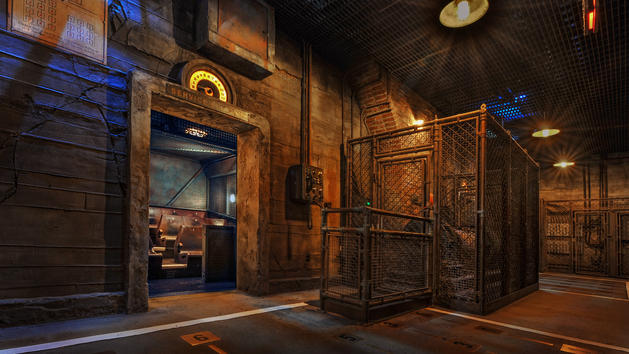
As the television sizzles out of service once more, a bellhop opens a concealed doorway into the ancient boiler room; the skeleton that powers the hotel. The flash from the luxurious lifestyle of the stars to the barren, desolate, and industrial infrastructure propping it up is a brilliant one, perfectly setting the stage for our arrival at a caged freight elevator, somehow still humming with life in this long-dead hotel.
Do you dare climb aboard? On the next page, we’ll ascend into our very own episode of The Twilight Zone.



